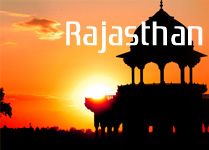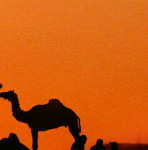 Entertainers and performers have been an integral part of the culture of Rajasthan since ages. The royal families had always been known to invite these performers at their courts and they traveled through the state, skillfully reciting and staging tales of both passion and valor. It was customary for the families to invite the Bhats, Dholis, Nats and Bhands to perform, sing and dance at all the family celebrations including births, marriages or any other festive occassions. Dholis feature in every Rajasthani marriage with their simple drums and deep bass of their voice. Some professional communities are known to give only typical performances especially in eastern Rajasthan. Bhopas usually sing only about Pabuji, a local hero and are also known for their Phad paintings. Then there are Kachhi Ghodi dancers, the puppeteers and the much-famed Kalbeliya dancers who are known for their rhythmic snake dances. The Langhas and Manganiyars from Jaisalmer have also got ample opportunities to give show performances all around the world in their simple and uncomplicated manner.
Entertainers and performers have been an integral part of the culture of Rajasthan since ages. The royal families had always been known to invite these performers at their courts and they traveled through the state, skillfully reciting and staging tales of both passion and valor. It was customary for the families to invite the Bhats, Dholis, Nats and Bhands to perform, sing and dance at all the family celebrations including births, marriages or any other festive occassions. Dholis feature in every Rajasthani marriage with their simple drums and deep bass of their voice. Some professional communities are known to give only typical performances especially in eastern Rajasthan. Bhopas usually sing only about Pabuji, a local hero and are also known for their Phad paintings. Then there are Kachhi Ghodi dancers, the puppeteers and the much-famed Kalbeliya dancers who are known for their rhythmic snake dances. The Langhas and Manganiyars from Jaisalmer have also got ample opportunities to give show performances all around the world in their simple and uncomplicated manner.Dances
We present you with the most popular of the various styles of dances in Rajasthan.
Bhavai: The heart skips a beat as we watch this rare feat, which is more akin to acrobatics set to the rhythm of the music, as veiled women dancers balance seven or nine brass pitchers on their heads and dance deftly, pirouetting and swaying while their feet are set on top of a glass or on the edge of a sword! Their every movement keeps the audience in suspense. Though, today, some of the performers use only papier-mache pots stuck together, their nimbleness is still a feat of wonder.
Drum Dance: It seems that performers are not much behind the warriors of Rajasthan when it comes to valor and chivalry. These people have a troupe of musicians with drums around their necks and cymbals in their hands used to create an ethereal music while the main performers put a naked sword in their mouths and juggle three other swords to the beat of the drums.
Fire Dance: One wonders whether scorching sands of Thar make the people here immune to burning from fire as Jasnaiths of Bikaner and Churu performs on a large bed of glowing coals, with more and more energy till the dancers appear to be in a near-hypnotic state. A devout devotional performance, the rhythmic choreography certainly does not end up in blisters on the dancers' feet. Generally performed late on a winter's night, it takes a lot of faith to witness it too.
 Chari: Dancers balance the brass pots with burning cottonseeds on their heads and create adroit patterns with their hands and the bright flames by swaying their heads. It is amazing to see how these performers move effortlessly on the floor and do not seem at all conscious of a potential danger of being burnt at all!
Chari: Dancers balance the brass pots with burning cottonseeds on their heads and create adroit patterns with their hands and the bright flames by swaying their heads. It is amazing to see how these performers move effortlessly on the floor and do not seem at all conscious of a potential danger of being burnt at all!Gair: Orignally a Bhil tribal dance to be performed at the time of Holi, there are several variations of this dance and is performed by both men and women. The men in long, pleated tunics opening out into full-length skirts as they move first in clockwise then in anti-clockwise movements and beat their sticks to create the rhythm when they turn. Quite similar to Garba of Gujarat, some of its variations are Dandia Gair of the Marwar region and Geendad of the Shekhawati region.
Ghoomar: Mainly performed by Rajput women on all the auspicious occasions, it has simple and graceful swaying movements. It is quite scenic as the colorful and embroidered skirts of the women flare as they twirl in circles with their faces covered by the veils. All the old and young women dance together, sometimes for many hours, and it is customary that a newly wedded bride performs ghoomar as one of the rituals of the marriage.
Kathak: Jaipur gharana is as famous as Lucknow gharana of Kathak (a former royal Indian classical dance mainly used to tell tales along with dancing). Known for the indefinite number of rounds, its performances are currently on a decline, today.
Kathputli: Puppeteering of Rajasthan is world-famous. A popular traveling form of entertainment, the puppeteer sings ballads behind the stage and is assisted by his family to erect a makeshift stage on which the puppets are strung and are made to enact tales of valor and romance. There are much screeching and high-pitched sounds that accompany the movements of the puppets across the stage.
Sapera Dance: Perhaps the most famous of all the Rajasthani dances, the women of Kalbeliya snake charmers wear long, black skirts embroidered with silver ribbons. The way, in which they spin in a circle and sway their bodies acrobatically, it seems as if they are made up of nothing but rubber. Wriggling like snakes themselves, the dancers are fervently energetic and perform with an increasingly quick tempo and pace.
 Kachhi Ghodi: This dance originated in the bandit regions of Shekhawati, where dancers wear highly structured costumes that give an impression as if they are riding on dummy horses. An energetic dance, it uses mock-fights, showing off swords, dexterous sidestepping and pirouetting to the melodious music of fifes and drums. The ballad that usually accompanies the dance is about the famous highway-man Robin Hood.
Kachhi Ghodi: This dance originated in the bandit regions of Shekhawati, where dancers wear highly structured costumes that give an impression as if they are riding on dummy horses. An energetic dance, it uses mock-fights, showing off swords, dexterous sidestepping and pirouetting to the melodious music of fifes and drums. The ballad that usually accompanies the dance is about the famous highway-man Robin Hood.Terah Taali: This devotional dance is customary in the Kamad community of Pokhran and Deedwana, in the honor of their folk hero, Baba Ramdeo. Women sit on the floor before his image, with thirteen cymbals tied to the various parts of their body. They strike these choreographically with the ones in their hand performing various arabesques. Occasionally, they also balance pots on their heads and hold a sword in their mouths to add to the theatrical effect of the performance.














